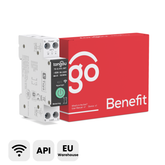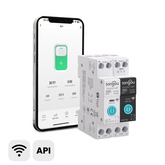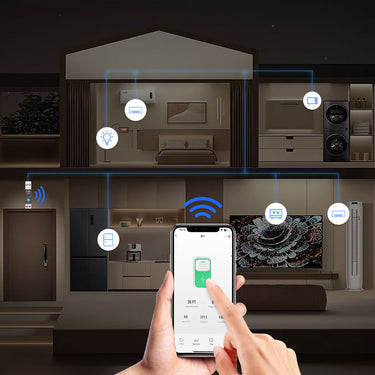Type A vs. Type AC RCBO: What‘s the Differences and How to Choose

When it comes to protecting your home or business from electrical hazards, Residual Current Circuit Breakers with Overcurrent protection (RCBOs) are indispensable devices. They offer dual protection: safeguarding against both overload/short circuits and dangerous earth leakage currents. However, navigating the world of RCBOs can be confusing, especially when you encounter different types like Type A RCBO and Type AC RCBO.
This blog post will break down the distinctions between these two common RCBO classifications, helping you understand their functionalities and confidently choose the appropriate one for your specific needs.
Understanding RCBOs: A Quick Recap
Before diving into the specifics of Type A and Type AC, let's quickly recap what an RCBO does. An RCBO is a combined device that integrates the functions of a Residual Current Device (RCD) and a Miniature Circuit Breaker (MCB).
-
Overcurrent Protection (MCB Function): Like a traditional circuit breaker, an RCBO trips and disconnects the circuit if it detects an overload (too much current being drawn) or a short circuit (a fault in the wiring). This prevents overheating and potential fires.
-
Residual Current Protection (RCD Function): This is the core safety feature. An RCBO constantly monitors the current flowing to and from a circuit. If it detects a difference (residual current), indicating current leakage to earth (which could be through a person touching a faulty appliance), it quickly trips, disconnecting the power and preventing electric shock.
The Crucial Difference: What Types of Residual Current Do They Detect?
The key distinction between Type AC and Type A RCBOs lies in the type of residual current they are designed to detect. This is where the letters "AC" and "A" become significant.
Type AC RCBO: Designed for AC Residual Currents
-
Detection Capability: Type AC RCBOs are designed to detect sinusoidal alternating residual currents. This means they are sensitive to the type of earth leakage currents that are typically produced by resistive loads. Think of appliances like:
-
Incandescent lighting
-
Heating elements (traditional heaters, ovens)
-
Simple motors without complex electronics
-
-
How it Works: Type AC RCBOs rely on the principle of magnetic induction from the alternating current to trigger the trip mechanism when a residual current is detected.
-
Limitations: Crucially, Type AC RCBOs are NOT designed to detect DC residual currents or pulsating DC residual currents. This is a significant limitation in modern electrical installations.
-
When to Use Type AC RCBOs (Historically): Type AC RCBOs were traditionally considered sufficient for basic installations with predominantly resistive loads. They are generally the more cost-effective option. However, their suitability is increasingly limited in contemporary settings.
Type A RCBO: Detecting AC and Pulsating DC Residual Currents
-
Detection Capability: Type A RCBOs offer a broader range of protection. They are designed to detect:
-
Sinusoidal alternating residual currents (like Type AC)
-
Pulsating direct residual currents
-
-
Why is Pulsating DC Detection Important? Many modern electronic devices and appliances, especially those with rectifiers, inverters, or speed controls, can generate pulsating DC residual currents in addition to AC residual currents. Examples include:
-
Modern LED lighting: LED drivers often produce DC components.
-
Power supplies: Used in computers, televisions, and many electronic devices.
-
Variable speed drives and inverters: Found in washing machines, dishwashers, air conditioners, and increasingly in renewable energy systems (solar inverters).
-
Electric Vehicle (EV) chargers: EV charging systems can generate DC fault currents.
-
Certain types of dimmers: Electronic dimmers can introduce DC components.
-
-
How it Works: Type A RCBOs use more sophisticated sensing technology that can respond to both AC and pulsating DC residual currents, ensuring a wider scope of protection.
-
When to Use Type A RCBOs (Recommended for Modern Installations): Type A RCBOs are strongly recommended for most modern electrical installations, especially those that include:
-
Homes with a variety of modern appliances and electronics.
-
Commercial buildings with electronic equipment, computers, and LED lighting.
-
Installations with EV chargers.
-
Systems incorporating solar power or other renewable energy sources.
-
Circuits supplying bathrooms and kitchens where appliances with electronic components are common.
-
Type AC vs. Type A RCBO: Key Differences Summarized
| Feature | Type AC RCBO | Type A RCBO |
| Residual Current Type Detected | Sinusoidal AC | Sinusoidal AC and Pulsating DC |
| Suitable for Resistive Loads | Yes | Yes |
| Suitable for Electronic Loads | Limited suitability, may not detect faults from many | Highly suitable, designed for modern electronics |
| DC Residual Current Detection | Yes | |
| Cost | Generally more cost-effective | Generally more expensive |
| Protection Level | Basic AC residual current protection | Enhanced protection, wider range of fault types detected |
| Recommended Use (Modern) | Increasingly limited, basic applications only | Recommended for most modern installations |
Choosing the Right RCBO: Prioritizing Safety
When selecting between Type AC and Type A RCBOs, safety should always be your top priority.
-
Assess Your Loads: Consider the types of appliances and equipment connected to the circuit you are protecting. If you have a significant number of modern electronics, LED lighting, or devices with inverters/rectifiers, Type A is the safer and more appropriate choice.
-
Modern Homes and Businesses: In most contemporary homes and commercial buildings, the prevalence of electronic devices makes Type A RCBOs the preferred option for comprehensive protection.
-
When in Doubt, Choose Type A: If you are unsure about the types of residual currents that might be present in your installation, opting for Type A RCBOs provides a wider safety margin and future-proofs your electrical system.
-
Consult a Qualified Electrician: For complex installations or if you are uncertain about your needs, always consult a qualified electrician. They can assess your specific situation and recommend the most suitable RCBO type to ensure optimal safety.
While Type AC RCBOs may seem like a more budget-friendly option initially, their limited detection capabilities can compromise safety in modern electrical environments. Type A RCBOs offer a significant advantage by detecting both AC and pulsating DC residual currents, providing enhanced protection against a wider range of potential electrical faults.











